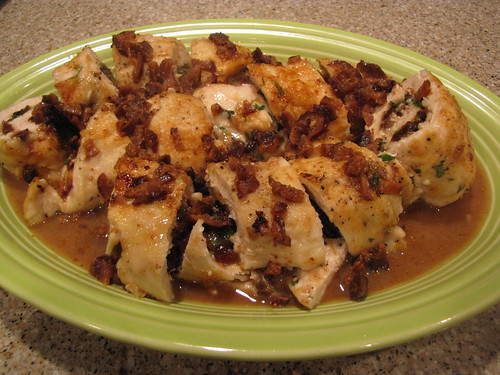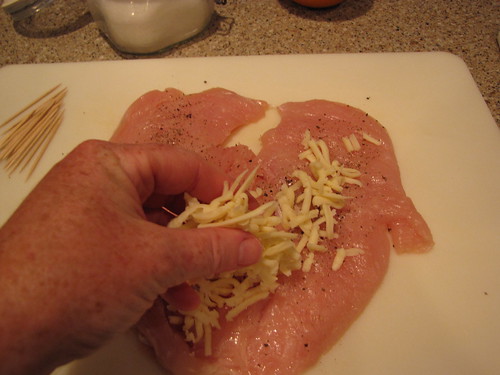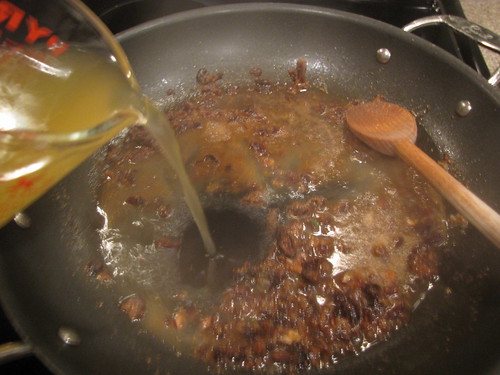Can you handle one more recipe in our Fig-a-thon?
How about chicken breasts, pounded thin, stuffed with creamy fontina cheese and dried figs, all rolled up and covered in a savory sauce?
Yes, I thought so too.
Moist and delicious, this recipe looks super fancy but is really a snap to prepare.
Here’s what you need:
Boneless skinless chicken breasts, dried mission figs, fontina cheese*, parsley, chicken broth, white wine, olive oil, flour, butter, salt & pepper. Wooden toothpicks also needed but not pictured.
*If your deli sells fontina cheese, you can simplify this recipe by buying 6-8 slices of fontina. If not, buy a 1/2 pound block and grate it yourself.
Click HERE for a Fig & Fontina Stuffed Chicken Shopping List
Preheat the oven to 400 degrees.
We’ve covered using fresh figs in several recipes including Fig & Rosemary Pork Tenderloin and Figs with Prosciutto & Blue Cheese. However this recipe uses dried figs which is great since they are available year round.
In my store, the dried figs are sold with the dried dates in the regular fresh produce section. You might also check near the other dried fruits like raisins.
To prepare the figs, grab 8 – 10 dried figs and cut off the little hard stem. Slice the figs into thin strips.
Dried figs are very sticky so just work slowly and carefully with a sharp knife. Set the sliced figs aside…these are the figs for stuffing the chicken.
Take 4 more figs and chop them into very small pieces. These are the fig bits for the delicious sauce.
Fontina Cheese — so nutty, soft and tasty. The original recipe calls for slices of fontina cheese but my deli counter was out of fontina so I bought a chunk of fontina and grated it. Either slices or grated will work just fine for this recipe.
Finely chop 1/4 cup of fresh parsley.
Now for the chicken. Trim any excess fat off the edges of boneless skinless chicken breasts. Place the chicken on a cutting board put your hand flat on top of the chicken to keep it from moving.
Starting at the more rounded edge of the chicken breast, CAREFULLY cut horizontally half way through the chicken. Don’t cut all the way through – leave the pieces attached so you can open them like a book. This is called “butterflying”.
Once you’ve started cutting, you can gently lift up the top piece of chicken to see how far you need to cut to keep the pieces together.
Open the chicken like a book and gently use your knife to score down the middle – but not cut all the way through – to help it lie flat.
Repeat this for the remaining chicken breasts.
To flatten the chicken, you will need some sort of pounding device. I have a heavy meat pounder/tenderizer. Notice that I am using the flat surface and not the pointy surface. You can also use a heavy rolling pin or even the side of a large, heavy can.
Wrap the chicken breast lightly in a large folded sheet of plastic wrap. This will protect the chicken, keep it from sticking to your counter, and also keep bits of chicken from flying all over the place.
Pound the chicken until it is flat and about 1/4 inch thick.
Start in the middle and pound your way toward the edges. Don’t worry if there are a few little holes or if it is not perfect.
You can leave the flat chicken in the plastic wrap until you have butterflied and pounded the remaining chicken breasts.
I should mention that this recipe can easily be adjusted to feed any size group. The original recipe called for 4 chicken breasts but I only had 3. Simply adjust the amount of fillings for whatever number of chicken breasts you are cooking. If you’re making more than 4, you should consider doubling the sauce ingredients.
Note: To keep from contaminating all your toothpicks with raw chicken cooties, when you have clean hands take about 12-15 toothpicks out of the box and set them on your work surface or cutting board.
To stuff the chicken, lay one of your flattened pieces out on a plate or cutting board and gently pat it dry with a paper towel.
Season with a little salt & pepper and sprinkle generously with grated fontina. Leave a little edge so that when you roll the chicken up, the stuffing doesn’t all ooze out.
Lay some of the sliced figs on top of the cheese…
and sprinkle with a little fresh parsley.
I’m not bothering to measure the filling ingredients…just try to make it come out even for the number of chicken breasts you have to stuff.
Start at one end and roll the chicken up over the filling.
If there is a shorter or more ragged edge, start rolling there so that it is on the inside of the roll.
Stick toothpicks in to hold the flap of the rolled chicken closed.
Repeat this process to stuff and roll the remaining chicken breasts.
Sprinkle 1/2 cup flour on a large plate. If the outside of your rolled chicken is a little damp, pat it dry with a paper towel and then gently roll the chicken in the flour to get a nice light coating. Shake off any excess flour.
Heat 2 Tablespoons of Olive Oil over medium high heat in a large pan. When the oil is hot place the floured chicken rolls in the pan and quickly brown on all sides.
I used 2 sets of tongs to carefully turn the rolls in the pan. Try not to squeeze them in the middle or the stuffing will all fall out.
Brown the chicken quickly over high heat – only about 1 minute per side – then transfer the rolled chicken to a foil covered baking sheet and bake in a 400 degree oven. Set the cooking pan aside to make the sauce.
Cook the chicken until the juices run clear and the inner temperature reaches 160 degrees on an instant read thermometer.
While the chicken bakes, make a quick sauce. Add the chopped figs and 1/2 cup white wine to the pan that you used to brown the chicken.
Cook over medium high heat for a couple of minutes using a spatula or wooden spoon to scrape up any browned bits from the bottom of the pan.
Add 1 cup of low sodium chicken broth and simmer over medium high heat until the sauce has reduced by half.
To finish the sauce, take it off the heat and stir in 2 Tablespoon of butter. Season to taste with salt & pepper.
When the chicken has cooked to 160 degrees, tent it with foil and let it rest for at least 5 minutes. This helps the juices to absorb back into the meat and also makes the chicken easier to slice.
Sadly, some of the cheese oozes out of the chicken when it cooks. I’ve yet to find a way to avoid that.
Remove the toothpicks and slice the rolled chicken into 2 inch pieces.
Drizzle the sauce over the sliced chicken and dig in!
This was delicious served with my favorite Green Beans with Caramelized Shallots and a nice hunk of crusty French Bread for soaking up the sauce.
Here’s the reipce – Adapted from Cook’s Illustrated


































